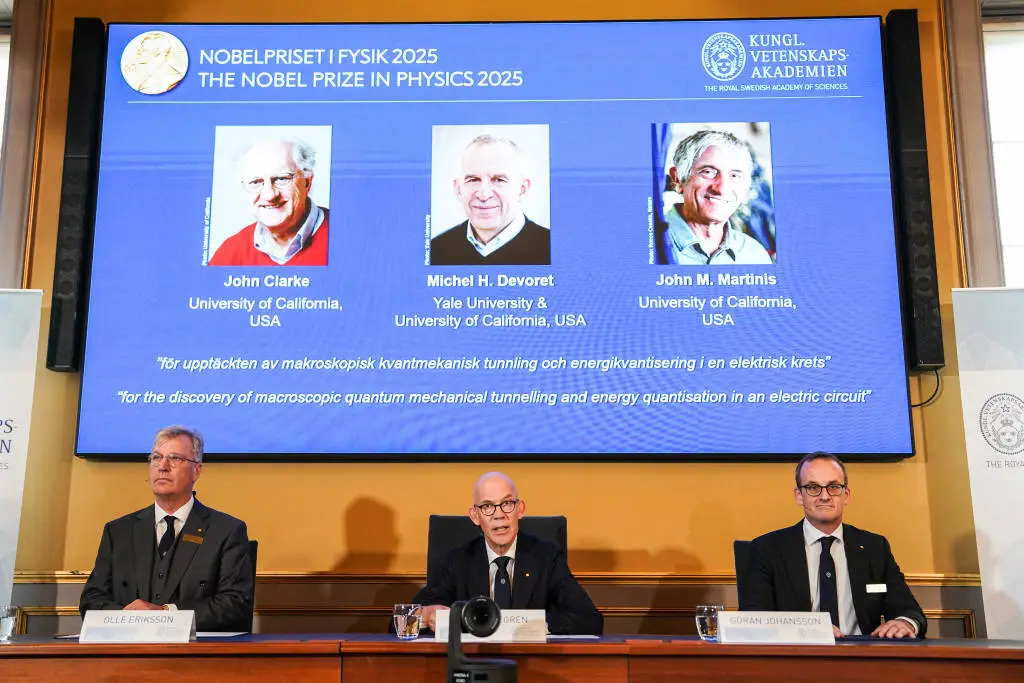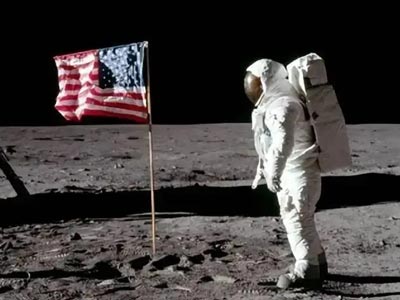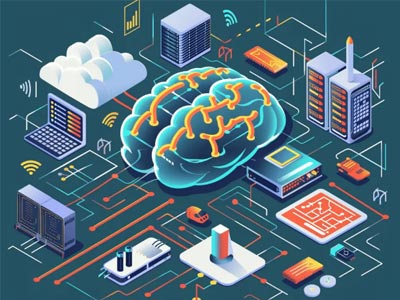"Scientists who have made significant breakthroughs in engineering, or have made significant contributions to the translation of research findings or the practical application of quantum computing, may also win the Nobel Prize."

The Royal Swedish Academy of Sciences announced on October 7 that three scientists have been awarded the 2025 Nobel Prize in Physics for their contributions to quantum mechanics. This is a photo taken at the 2025 Nobel Prize in Physics announcement in Stockholm, Sweden, on October 7.
On October 7, local time, the Royal Swedish Academy of Sciences awarded the 2025 Nobel Prize in Physics to scientists John Clarke, Michel H. Devoret, and John M. Martinis for their "discoveries of macroscopic quantum mechanical tunneling and energy quantization in circuits."
Through a series of experiments, the three scientists demonstrated that the unique properties of the quantum world can be manifested in macroscopic systems. The superconducting circuit system they designed can tunnel from one state to another as if passing through a wall. They also demonstrated that the system absorbs and releases energy at specific "doses," exactly as predicted by quantum mechanics. The three laureates will share the 11 million Swedish kronor prize.
Transistors in computer microchips are an example of mature quantum technology that is already all around us. This year's Nobel Prize in Physics offers opportunities for developing next-generation quantum technologies, including quantum cryptography, quantum computers, and quantum sensors. Ole Ericsson, Chair of the Nobel Prize Committee for Physics, said, "It is wonderful to celebrate a century of quantum mechanics, which continues to offer new surprises. It is also extremely significant because quantum mechanics is the foundation of all digital technologies."
Quantum computing is considered one of the core areas of the future technological revolution, and the contributions of the three laureates represent a significant step forward in the development of superconducting quantum computing.
Observing quantum tunneling at the macroscopic scale
After receiving his doctorate from the University of Cambridge in 1968, Clarke moved to the United States and formed his own research group at the University of California, Berkeley, focusing on exploring various physical phenomena using superconductors and Josephson junctions. In the mid-1980s, after receiving his doctorate in Paris, France, Devoret joined Clarke's research group as a postdoctoral fellow. Martinis, a doctoral student at the time, was also on the group. Together, the three took on the challenge of demonstrating macroscopic quantum tunneling.
Quantum mechanics describes remarkable properties at the scale of single particles. In quantum physics, these scales are far smaller than the limits of observation with optical microscopes, in stark contrast to "macroscopic phenomena." Macroscopic phenomena are composed of numerous particles. For example, an everyday ball is composed of countless molecules and exhibits no quantum mechanical effects. Every time a ball hits a wall, it bounces back. However, in the microscopic world, individual particles can sometimes pass directly through the equivalent "barrier" and emerge on the other side. This quantum mechanical phenomenon is known as tunneling. This year's Nobel Prize in Physics recognizes experiments that demonstrated that the tunneling effect can be observed at the macroscopic scale involving large numbers of particles. Clarke, Devoret, and Martinis conducted a series of experiments at the University of California, Berkeley, from 1984 to 1985. They constructed a circuit consisting of two superconductors separated by a thin layer of a completely non-conductive material. They successfully optimized the circuit and measured all its properties, gaining a deep understanding of its operation.
In their experiments, they successfully controlled and observed a phenomenon in which all the charged particles in the superconductor behaved in concert, as if they were a single particle filling the entire circuit. This particle-like system was trapped in a "zero voltage current state"—a state in which current can flow without the need for voltage, and the system lacked sufficient energy to escape. In the experiment, the system escaped this zero voltage state through tunneling, generating voltage, demonstrating quantum properties.
The three laureates also demonstrated that the system exhibited "quantum" characteristics, meaning that it absorbed or released energy only at specific energy levels. They introduced microwaves of varying wavelengths into the zero-voltage state and found that some of the microwaves were absorbed by the system, which then transitioned to a higher energy level. This result indicates that the higher the system's energy, the shorter the duration of the zero-voltage state, which is consistent with the predictions of quantum mechanics, much like the behavior of microscopic particles trapped by a barrier.
Creating Possibilities for the Development of Quantum Computer Technology
Previously, other quantum effects observed at the macroscopic scale were mostly composed of a large number of "microscopic units" and their individual quantum properties. However, this experiment directly generated a macroscopic effect—a measurable voltage—from a state with inherent macroscopic properties.
Theorists such as Anthony Leggett compared the three laureates' "macroscopic quantum system" to Erwin Schrödinger's cat thought experiment. In this experiment, the cat remains in a superposition of both alive and dead unless the box is opened for observation. Schrödinger proposed this thought experiment to highlight the absurdity of this state, as the unique properties of quantum mechanics often vanish at macroscopic scales, making it impossible to observe the overall quantum properties of a cat in the laboratory. Leggett argues that the series of experiments by Clarke, Devoret, and Martinis demonstrate the existence of "large numbers of particles coordinating and behaving exactly as predicted by quantum mechanics." Because this experiment measures "quantum mechanical properties applicable to the entire system," it comes very close to Schrödinger's vision of a "quantum cat" for quantum physicists.
This type of macroscopic quantum state offers new possibilities for experimenting with phenomena in the microscopic world of particles. It can be considered a "large-scale artificial atom," equipped with wires and interfaces that can be connected to new experimental setups or applied to novel quantum technologies. For example, this "artificial atom" can be used to simulate other quantum systems, helping researchers understand their properties.
Superconducting circuits are also currently being explored as a promising approach to building future quantum computers. This year's Nobel Prize in Physics opens the door to the development of next-generation quantum technologies, including quantum cryptography, quantum computers, and quantum sensors. Martinis' subsequent quantum computer experiments exploited the properties of energy quantization. He used circuits in quantized states as "information carrier units" (or qubits), where the lowest energy level and the adjacent higher energy level correspond to 0 and 1, respectively.
Ying Jianghua stated that superposition and entanglement are two fundamental properties of quantum mechanics. It is precisely because of these two properties that computing power can increase exponentially with the number of qubits, achieving the superiority of quantum computing. Theoretically, once the number of qubits exceeds 49, computing power could surpass the most powerful classical computers currently available.
"Martinis' most important contribution was demonstrating the superiority of superconducting quantum computing," Ying Jianghua said. Martinis is a landmark figure in the field of superconducting quantum computing. He previously led Google's superconducting quantum computing team and made significant contributions to the engineering and practical applications of quantum computing."




